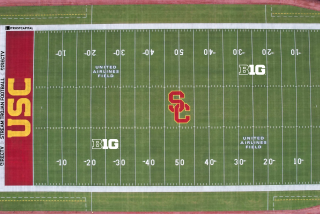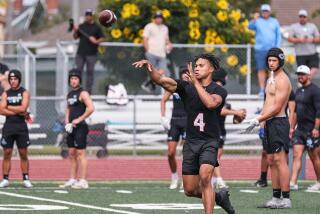For Fullerton Football, the Check Is in the Mail : Payoffs for Struggling Division I Teams Are More in Dollars Than in Wins
Sometime in the next three months, Ed Carroll, Cal State Fullerton athletic director, will receive an envelope in the mail.
Inside will be a check, made out for $200,000, payable to Cal State Fullerton, and drawn on a Louisiana State University account.
Whether that amount will be sufficient solace for the drubbing the Titans are likely to receive at the hands of the sixth-ranked Tigers tonight at Baton Rouge, La., remains to be seen.
What is significant is that Fullerton, in a single day, will have offset a large portion of its $1.1-million football budget, at the likely cost of expenses, a bit of pride, perhaps a few injuries and--almost certainly--a loss.
Two weeks from today, Cal State Long Beach plays Michigan at Ann Arbor, Mich. The football program at Long Beach has been in such financial straits that President Stephen Horn threatened last November to drop the sport unless $300,000 was raised by Dec. 31.
That Michigan payday will be about $300,000--a figure that can help significantly an athletic department that had accumulated a deficit of $719,000 at the end of last year.
For programs such as Fullerton and Long Beach, and many more like them across the country who are struggling to play Division I football on a shoestring budget, playing big-name opponents on the road for big guarantee checks is a way to survive. It is not a way, however, to win a lot of games.
Last week, North Texas State opened its season at top-ranked Oklahoma, then had to listen to Barry Switzer say after a 69-14 victory that the Sooners had looked âragged.â It was worth $140,000 to the Division I-AA Eagles.
Utah State, a Pacific Coast Athletic Assn. team that went 3-8 last year, lost to second-ranked Nebraska, 56-12, last week, only to hear Tom Osborne say he had âmixed feelings.â But Utah State Athletic Director Rod Tueller said the school earned around $200,000. Today, the Aggies will make another $100,000 at Kentucky.
âThatâs kind of the cold hard thing,â Tueller said. âWe have to do this.â
Fullertonâs Carroll may well be one of the best around at scheduling these big-name, big-money (and usually, big-score) games, somewhat to the chagrin of Coach Gene Murphy, whose team must play those schedules.
Carrollâs success in scheduling apparently is a result of an aggressiveness and persistance that would befit any job-searching new grad.
He prepared a letter listing Fullertonâs qualities and aims, and then sent it to every major-college athletic director in the country, suggesting a profitable meeting on the field.
âYou get some noâs. You get some who say, âWeâre filled up, weâll keep you on file,â Carroll said. âA lot donât even bother to respond. Some work out.â
This year, in addition to LSU, Carroll scheduled a game at Florida on Oct. 10. That one will bring in another $200,000. In seven road games, the Titans will earn $625,000, far exceeding the $188,000 of two years ago. Subtract the $175,000 travel budget, and Fullerton clears $450,000, money that will help put the program in the black and perhaps move the current 80 scholarships closer to the NCAA-limit 95.
Apparently, Carroll also drives a hard bargain. Temple will receive about $75,000 less than Fullerton at Florida. The Titans last week played the final game of 10 against Hawaii, a series that may not continue. âHe wants too much money,â said Hawaii Athletic Director Stan Sheriff.
Still, LSU and Florida are not Carrollâs idea of the perfect opponent.
âIdeally, we like to find teams that have a good payoff and that we also have a chance to beat,â he said.
Temple, an Eastern independent, is another school that schedules very competitive away games. Temple regularly books Penn State, but must settle for two or three road games to every one at Philadelphiaâs Veterans Stadium, where Temple plays its home games. This season, Temple will play at Florida, and next seasonâs schedule includes a game at Alabama.
In the cases of such schools as Fullerton, Long Beach and Temple--all urban commuter campuses in very competitive sports markets that do not have on-campus stadiums--the need to make money on the road is magnified by the difficulty of making it at home.
Fullerton, 3-9 last year in its first losing season in four years, drew an average of only 3,828 to three games at Santa Ana Stadium. Long Beach drew an average of 6,300 to Veterans Stadium.
Home-game gate receipts and the accompanying concessions, advertising and program sales usually are the chief sources or revenue for football programs, but at Fullerton, associate athletic director Steve DiTolla expects to take in only $67,050 in five games, including season ticket sales.
Temple, which no longer uses its deteriorated on-campus stadium, averages about 20,000 in 60,000-capacity Veterans Stadium.
âThat just doesnât cut it, aesthetically or financially,â said Milt Richards, Templeâs associate athletic director for business operations. There are other methods besides seeking large guarantees that are used to help make ends meet by these low-budget programs. Temple, whose football budget averages about $1.5 million, compared to Oklahomaâs approximately $4.5 million, has taken to holding concerts at Veterans Stadium after some games, in an effort to boost attendance.
In the past, such groups as the Beach Boys, Kool & the Gang and the Monkees have performed.
Fullerton cuts corners on travel by buying economy class airline tickets well in advance, rather than chartering.
âEvery time we do that, we save $10,000 or $15,000,â DiTolla said. âThatâs scholarships.â
Scheduling, though, has far and away the most financial impact. Still, one has to wonder if the means suit the goal. Schools want money to finance and build better football programs, so they book high-paying teams--teams that are likely to beat them soundly.
There is always the chance, of course, that one of these teams will win an upset, as Miami (Ohio) did against LSU last year. But only rarely.
Still, these schools, for the most part, persist.
âWeâve had some suggestions that maybe we ought to consider not having a team,â said Utah Stateâs Tueller. âBut we think college football is an integral part of the liberal arts campus. Weâre going to continue.â
At Fullerton, the belief is that the planned on-campus stadium that is to be begun this year, plus the construction of dormitories, will help solve the problems.
âOnce we get that feeling on campus that somethingâs going to happen on Saturday, weâll be on our way,â said DiTolla, who on walks across campus eyes each student as a potential ticket-buyer and future alum. âThe students are the key. The city will follow.â
More to Read
Go beyond the scoreboard
Get the latest on L.A.'s teams in the daily Sports Report newsletter.
You may occasionally receive promotional content from the Los Angeles Times.










